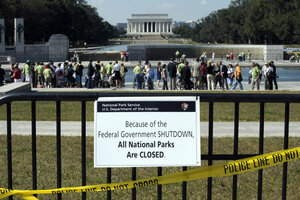Government shutdown didn't save money. It cost $2 billion, report says.
From a budgetary perspective, the government shutdown was a lose-lose scenario, with federal employees sitting at home getting no work done but then later getting paid for it.

Despite signs stating that the national parks are closed, people visit the World War II Memorial in Washington on Oct. 2.
Susan Walsh/AP/File
Washington
The federal government’s partial shutdown last month was a costly exercise in agreeing to disagree. Now we know exactly how costly.
Or at least, we have a preliminary price tag estimated by the Obama administration.
The roughly two-week hiatus in many federal operations represents “cost of lost productivity” exceeding $2 billion, says Sylvia Mathews Burwell, director of the White House Office of Management and Budget (OMB).
That’s not an estimate of the total economic costs of the shutdown. It’s just the cost that accrues to taxpayers from taking thousands of federal employees off the job, not getting any work out of them for a couple of weeks, and then restoring their lost pay after the shutdown ended.
Economists say this practice makes no sense, yet it’s become a pattern for those rare occasions when a budget impasse between Republicans and Democrats results in a temporary refusal to fund government operations.
In those cases, the result is a lose-lose situation. It interrupts the paychecks of federal workers, disrupts federal services that many Americans count on, while eventually making sure workers get paid for the time that Congress told them to stay home.
Although Ms. Burwell didn’t try to quantify the effect on the nation’s economic output, she said that independent forecasters have estimated that the shutdown will subtract 0.2 to 0.6 percentage points from the fourth quarter growth (with the economy growing in the neighborhood of 2 percent per year).
Late last month, President Obama’s Council of Economic Advisers estimated that the slowdown in growth hindered private sector employment, costing an estimated 120,000 jobs.
An OMB report released Thursday sheds additional light on the shutdown’s impacts. Here are some of the details:
Energy. About 200 drilling permits were delayed because the Bureau of Land Management was unable to process applications.
Science. “Critical government-sponsored scientific research was put on hold,” the report said. “Four of the five Nobel prize winning scientists who work for the Federal government were furloughed during the shutdown.”
Foreign trade. Import and export licenses and applications were put on hold, negatively impacting trade.
Tax refunds. Almost $4 billion in tax refunds were delayed.
Fisheries. The shutdown delayed the Alaskan crab fishing season, because the National Oceanic and Atmospheric Administration was unable to apportion harvest levels. This means some lost industry revenue, “since days lost at the beginning of the season cannot be made up later.”
Aircraft purchases. Closure of the Federal Aviation Administration’s aircraft registry delayed an estimated 156 aircraft deliveries valued at $1.9 billion.
Late fees. The federal government will owe interest because the shutdown delayed payments such as money owed to contractors. Burwell didn’t put a dollar figure on the interest costs, but the report said “billions of dollars of payments” were late.
Tourism. Closure of national parks and Smithsonian museums cost an estimated $500 million in lost visitor spending nationwide, an “economic hit to communities surrounding national parks.”
Furloughs for federal workers. Federal employees sat home for a combined total of 6.6 million days, more than in any previous government shutdown. This exceeded the total in a 1995-96 episode in part because back then, Congress had passed appropriations bills that funded many federal agencies despite the shutdown. This time, at peak, about 850,000 employees were on furlough at one time.
Many government services such as Social Security and unemployment benefits continued as usual during the recent shutdown, because they were labeled “essential” or had sources of funding that don’t depend on annual appropriations from Congress.

